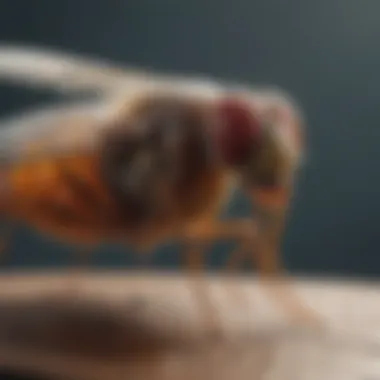Effective Solutions for Fruit Fly Infestations


Intro
Fruit flies are a common nuisance in many households. Their small size and rapid reproduction rate can make them difficult to control once an infestation occurs. Understanding the biology and behavior of these pests is crucial for homeowners seeking effective solutions. In this guide, we will explore methods to identify fruit flies, prevention techniques, and do-it-yourself pest control solutions. With the right information, homeowners can effectively combat these pests and maintain a clean living environment.
Pest Identification
Common Household Pests
Fruit flies, scientifically known as Drosophila melanogaster, are typically recognized by their tan or light brown color and red eyes. These flies thrive in environments with decaying fruits and vegetables, making kitchens and pantries prime targets. Unlike larger pests, fruit flies are often overlooked until they multiply into larger swarms.
Signs of Infestation
Identifying a fruit fly infestation is critical. Common signs include:
- Persistent presence of small flies in the kitchen.
- Adults near ripe or rotting fruits and vegetables.
- Small clusters of eggs visible on decomposing produce.
A quick inspection can reveal where these pests are breeding and enable prompt action.
Prevention Methods
Environmental Modifications
To prevent fruit flies from entering your home, consider modifying your environment. Maintain cleanliness and take these steps:
- Clear away any overripe or rotten fruits and vegetables.
- Store produce in the refrigerator when possible.
- Dispose of garbage regularly and use tightly sealed bags.
Home Maintenance Tips
Regular home maintenance can also deter fruit flies. Implement the following practices:
- Check and clean drains regularly to remove organic residue.
- Seal cracks or gaps around windows and doors to keep flies out.
- Use insect screens in windows and doors to inhibit entry.
By maintaining a tidy and well-maintained space, the attraction for fruit flies can significantly diminish.
DIY Pest Control Solutions
Natural Remedies
There are several natural remedies that can effectively eliminate fruit flies. Consider using:
- A mixture of apple cider vinegar and dish soap in a bowl. This combination attracts the flies, while the soap traps them.
- A solution of water and essential oils, like eucalyptus or lemongrass, to repel flies.
DIY Traps and Barriers
Creating simple traps can help control fruit fly populations. Here are some effective options:
- Vinegar Trap: Pour apple cider vinegar into a jar, covering it with plastic wrap. Poke small holes in the wrap. Flies are attracted to the vinegar but struggle to escape.
- Wine Trap: Similar to the vinegar trap, an open bottle of wine can attract flies. The tapered neck prevents their escape.
"Consistency in cleaning and monitoring can significantly reduce the chances of a fly infestation."
By employing these methods, homeowners can gain control over fruit fly populations, preventing further infestations.
Understanding Fruit Flies
Understanding fruit flies is crucial for effective pest control. Knowledge of their behavior, biology, life cycle, and what attracts them to certain areas will help in creating targeted solutions. Such understanding enables homeowners to act proactively rather than reactively, minimizing the likelihood of an infestation before it begins.
Biology and Behavior
Fruit flies, specifically Drosophila melanogaster, are small insects that are around 1/8 inch long. They are characterized by red eyes and a tan body. Their rapid reproduction cycle is a hallmark feature. Females can lay up to 500 eggs in a matter of days, which can lead to large populations nearly overnight. The adults are often seen in homes wherever there is a food source, particularly fruits and vegetables. They have very short lifespans, usually about 30 days, but the quantity of offspring produced in this time can quickly lead to infestations. Understanding their behavior helps in predicting their movements and habits within the home.


Life Cycle of Fruit Flies
The life cycle of fruit flies consists of several stages: egg, larva, pupa, and adult. The entire process can be completed in about a week under favorable conditions, which means that without intervention, it can be quite easy for a small issue to escalate into a significant problem.
- Eggs: Females lay eggs on the surface of fermenting or rotting fruit.
- Larvae: After approximately 24 hours, the eggs hatch into larvae. They feed on the decaying organic material, growing rapidly.
- Pupae: After a few days, the larvae seek a drier place and transition into pupae. This stage lasts about four to six days.
- Adults: Finally, the adult fruit flies emerge. At this point, they are ready to mate and reproduce, starting the cycle over.
Understanding each stage of their life cycle is important, as it allows for strategic interventions at the right time to break this cycle and control their population.
Attraction Factors
Fruit flies are attracted to certain factors in their environment. Identifying these factors can facilitate preventive measures. Key attractants include:
- Ripened or overripe fruits: They are drawn to the scent emitted by fermenting fruit.
- Vegetables: Decaying vegetables can also attract fruit flies when they begin to rot.
- Fermented items: Open containers or spills containing wine, beer, or vinegar are highly alluring to fruit flies.
- Hidden food sources: Any hidden organic material such as old wine corks or damp areas can serve as hiding spots.
By reducing these attractants in the home, the probability of an infestation can be minimized. Identifying and understanding these factors is essential for effective pest prevention.
Signs of Infestation
Recognizing signs of fruit fly infestation is crucial for effective pest control. Early detection can prevent a minor problem from becoming a serious issue. Understanding the indicators of an infestation enables homeowners to take timely action.
Visual Indicators
Visual indicators of fruit flies are often the first signs that alert homeowners to a possible infestation. These small flies are typically around 1/8 inch long, with a brownish or yellowish body. Their wings are usually clear and may have a black pattern.
Common visual signs include:
- Presence of adult flies: An increase in adult fruit flies around areas where food is present is a clear warning signal.
- Larvae: Look for tiny, white larvae in overripe or rotting fruits. These larvae are often found in places where fruit flies breed.
- Small fly traps: If you start seeing more traps filled with adult flies, it may indicate a growing population.
Thorough observations in kitchen spaces and dining areas are essential. If fruit flies are spotted consistently, begin to assess potential breeding sites nearby.
Subtle Symptoms
Subtle symptoms may not be as obvious as visual ones, yet they play an important role in detecting fruit flies. Homeowners should pay attention to secondary signs that could indicate an infestation.
Here are some subtle symptoms to consider:
- Food spoilage: Check for fruits or vegetables that seem overly ripe or have started to decay. Spoiled produce attracts fruit flies and may indicate a breeding site.
- Unpleasant odors: A lingering smell, especially near garbage or compost piles, can indicate that fruit flies are nesting nearby.
- Frequent sightings of flies: If you notice fruit flies hovering near food items, dishes, or kitchen counters, it suggests that an infestation may be developing.
These symptoms can sometimes be overshadowed by daily activities. However, taking the time to note these signs is essential for early intervention.
Prevention Strategies
Preventing fruit flies is an essential step in controlling their population and minimizing the discomfort they cause. A proactive approach focuses on two main areas: kitchen practices and environmental manipulation. Implementing these strategies can keep your home free from infestations. Understanding the role of prevention helps not only in avoiding future problems but also in ensuring a healthier living environment.
Kitchen Practices
Proper Storage of Fruits
Proper storage of fruits serves as a vital preventive measure against fruit flies. Fruits often release ethylene gas, which attracts these pests. To combat this, it is important to store fruits in sealed containers or the refrigerator when not in use. This minimizes their exposure and reduces the chances of attracting fruit flies. Keeping ripe and overripe fruits separate and disposing of them promptly is also recommended. The key characteristic of proper storage is its simplicity. It does not require special products; it is just about organized space. Many people find this method beneficial as it helps preserve the freshness of fruits and minimizes waste. On the downside, forgetting to check stored fruits could lead to infestations. Being consistent can aid in maintaining an effective prevention strategy.
Regular Cleaning Routines
Regular cleaning routines significantly contribute to maintaining a fruit-fly-free kitchen. Keeping surfaces clean reduces the chances of leftover food or spilled liquids that can attract these pests. Wiping counters, regularly cleaning under appliances, and disposing of trash frequently are all part of this strategy. The main characteristic of regular cleaning is its fundamental nature. It is an activity that fosters overall hygiene, making it a popular choice among homeowners. Not only does it deter fruit flies but it also discourages other pests. A disadvantage can arise from neglecting cleaning duties, leading to an inviting environment for fruit flies. Therefore, establishing a routine can help ensure long-term success in pest management.
Environmental Manipulation
Eliminating Breeding Grounds
Eliminating breeding grounds is crucial for effective fruit fly management. Fruit flies often breed in decaying organic matter or fermenting substances. Clearing out any food debris, especially in hidden areas, is important to prevent breeding. This method requires vigilance in identifying potential breeding sites like old fruit, spills, or garbage.
The significant aspect of eliminating breeding grounds is its direct impact on reducing the fruit fly population. It is a proactive choice that ensures fewer larvae are born, thus lowering adult numbers. Moreover, this approach can enhance overall cleanliness and hygiene in the home. The downside, however, is that it may require thorough inspections and frequent checks to remain effective.


Controlling Moisture Levels
Controlling moisture levels is another effective measure in preventing fruit flies. These pests thrive in damp environments, so keeping areas dry is paramount. Fixing leaks, using dehumidifiers, and ensuring good ventilation can significantly help in moisture control. The primary feature of controlling moisture is its effectiveness in discouraging various pests, not just fruit flies. Thus, it is a beneficial strategy for creating a less attractive environment for insects. A drawback can be the need for ongoing maintenance to keep moisture levels low. Without consistent effort, the benefits can diminish, making this strategy less effective over time.
Home Remedies
Home remedies play a crucial role in addressing fruit fly infestations. These methods are often cost-effective and accessible, making them appealing to homeowners. Using everyday household items can lead to significant reductions in fruit fly populations without the need for harsh chemicals. Additionally, home remedies allow for more control over the pest control process.
Vinegar Traps
Vinegar traps are one of the most popular and effective home remedies for catching fruit flies. This method is simple: vinegar, particularly apple cider vinegar, attracts fruit flies due to its scent, which mimics the smell of ripe fruit.
To create a vinegar trap:
- Take a small bowl or jar.
- Pour in about an inch of apple cider vinegar.
- Add a drop of dish soap, which breaks the surface tension, preventing the flies from escaping.
- Cover the jar with plastic wrap and secure it with a rubber band. Poke a few holes in the wrap, allowing flies to enter but not escape.
Place these traps near infested areas, such as kitchens or fruit bowls. Check them regularly and replace the mixture as needed. This method is environmentally friendly and prevents the use of toxic chemicals in your home.
Fruit Bait Solutions
Fruit bait solutions can also be effective for catching fruit flies. This method uses the natural lure of overripe or rotting fruits to attract flies. By strategically placing these baits, homeowners can effectively reduce fly populations.
To implement fruit bait solutions:
- Choose fruit that is particularly ripe, such as bananas or peaches, which are known to attract fruit flies.
- Cut the fruit into pieces and place them in a bowl.
- Cover the bowl with plastic wrap, similar to the vinegar trap, and poke holes in the top.
- Alternatively, place the fruit directly in a container without covering it—though this may lead to messier results.
The scent of the ripe fruit will draw flies in, where they will often become stuck, or there can be a significant increase in captures. This solution uses natural elements found in many kitchens, reducing waste and serving a double purpose.
Soap and Water Trap
The soap and water trap is another straightforward method that leverages basic household items to catch fruit flies safely. The combination of soap and water can effectively immobilize these pests.
Here’s how to create this trap:
- Fill a bowl or jar with a mixture of water and dish soap.
- The soap reduces the surface tension of the water, causing the flies to sink and drown.
- You can enhance this trap's effectiveness by adding a splash of apple cider vinegar or a piece of overripe fruit.
Position the trap near problem areas, like near fruit storage. Regularly check and refresh the mixture to maintain its effectiveness.
Using home remedies not only helps in controlling fruit fly populations but also minimizes exposure to harmful pesticides in your home environment.
Implementing these home remedies can lead to noticeable results in fruit fly management while being safe for your household. They illustrate how simple, everyday items can serve important purposes in pest control.
Commercial Solutions
Commercial solutions for fruit fly infestations provide homeowners with effective tools to manage and eliminate these pests. With busy lifestyles, relying on quick-fix methods can be essential. The use of store-bought insecticides and bait products can help capture or kill fruit flies efficiently. However, it is important to understand the benefits and considerations of these methods before relying on them.
These solutions can often yield faster results than home remedies, which may be slower to act. Many commercial products are designed not just to kill adult flies, but also to disrupt the breeding cycle. By choosing the right product, you can target both adult flies and their larvae, reducing the chances of a resurgence of the infestation.
"Choosing commercial products can offer immediate relief in fruit fly control, but understanding their components and usage is critical for safety and efficacy."
When selecting commercial solutions, safety must be a priority. Many insecticides contain chemicals that can be harmful to children and pets. Therefore, it is crucial to read labels and follow usage instructions closely. Here, we delve into two main categories of products used for combating fruit fly issues: insecticides and bait products.
Insecticides Review
Insecticides are widely available and often effective against fruit flies. Most common insecticides for fruit flies include pyrethrins, which are derived from chrysanthemum flowers. These products work by attacking the insect's nervous system, leading to paralysis and death.
Before applying insecticides, consider the following points:
- Targeted Application: Spray only in areas where fruit flies are seen. This will help minimize exposure to non-target insects.
- Timing: Applying insecticide during the peak fruit fly activity hours, typically early morning or late afternoon, can improve effectiveness.
- Safety Measures: Always ventilate the area before and after applying any chemical products.


Be aware of the potential for chemical resistance among pests. Rotate between different types or brands of insecticides to reduce this risk. Regular monitoring and observation are key to knowing whether a product is still effective.
Bait Products Analysis
Bait products provide another effective method for controlling fruit fly populations. These products typically combine a poison with a food attractant, enticing fruit flies into traps. Its mechanism allows for the targeting of adult flies, which reduces their ability to reproduce.
When considering bait products, keep these aspects in mind:
- Ease of Use: Most bait products come ready to use, requiring minimal setup. Simply place them in areas where flies are prevalent.
- Selection of Bait Type: Different baits cater to various preferences. Some flies may be attracted more to sugary or fermented food sources. Choosing the right attractant can enhance success rates.
- Ongoing Maintenance: Regular checks are necessary to replace used bait and ensure uninterrupted control of the flies.
Furthermore, bait products are generally safer than insecticides as they have lower toxicity for humans and pets when used correctly. However, always review product warnings and instructions on safe usage.
Long-Term Management
Long-term management of fruit fly problems is essential for creating a sustainable and pest-free environment in any household. Understanding that fruit flies can become a recurring issue highlights the necessity of ongoing strategies rather than temporary fixes. This approach ensures that not only are current infestations handled, but future opportunities for these pests to invade are curtailed.
Implementing long-term management practices offers several benefits. Firstly, it minimizes the reliance on chemical interventions, helping in preserving both the household environment and the ecosystem. Secondly, by fostering proper habits, homeowners can effectively reduce behaviors that attract fruit flies, thus breaking the cycle of infestation. This proactive mindset contributes to a cleaner kitchen and overall improved hygiene.
Additionally, long-term management encourages routine and consistent monitoring. Regular checks can detect potential breeding sites or food sources that may not be immediately obvious. Ultimately, forming habits that prioritize cleanliness and monitoring plays a pivotal role in achieving lasting success against fruit flies.
Monitoring Techniques
Monitoring techniques are vital to long-term management of fruit flies. They ensure that any signs of infestation are caught early, facilitating quicker remedies. Two main aspects of effective monitoring include the use of sticky traps and conducting regular inspections.
Using Sticky Traps
Sticky traps continue to be a popular choice for monitoring fruit fly activity due to their simplicity and effectiveness. These traps utilize an adhesive surface to catch flying insects. The key characteristic of sticky traps is their ability to provide instant feedback on infestation levels. If homeowners notice a high number of flies collected on the traps, it signals a potential problem that needs addressing.
A unique feature of sticky traps is their capacity to reveal the type of fruit flies present. This can assist in tailoring specific management strategies. The advantages of sticky traps include their low cost and non-toxic nature, making them safe for home use. However, they do require regular checking and replacement, which may be seen as a disadvantage for some.
Regular Inspections
Regular inspections are another crucial component of monitoring techniques. This practice involves systematically checking various areas of the home, particularly places like kitchens and storage areas where fruit flies are commonly found. The key benefit of regular inspections is that they foster a habit of attentiveness, allowing homeowners to notice unusual activities or signs of infestation early on.
Through regular inspections, unique features can be identified, such as hidden breeding sites or overlooked trash bins. This contributes significantly to comprehensive pest control efforts. Furthermore, the process of inspecting helps maintain cleanliness by encouraging a routine of cleanliness checks. The downside lies in the need for time investment to perform thorough evaluations, which some may find challenging in their busy schedules.
Adapting Household Habits
Adapting household habits is crucial in enforcing long-term management of fruit flies. By making minor adjustments in daily routines, homeowners can greatly reduce the likelihood of attracting these pests. Two main habits to consider are maintaining cleanliness and implementing an integrated pest management approach.
Maintaining Cleanliness
Maintaining cleanliness is perhaps the most fundamental strategy in fruit fly management. This involves consistently cleaning food spills, disposing of overripe produce, and frequently taking out the trash. The main characteristic of this habit is its straightforward application: a clean home naturally attracts fewer pests.
A unique feature of this strategy is its ability to integrate into daily chores. Homeowners easily can incorporate cleanliness into their routines without needing specialized knowledge. However, while this method is effective, it may require continuous effort and vigilance, particularly in food storage areas, which can become testing.
Implementing an Integrated Pest Management Approach
The Integrated Pest Management (IPM) approach is a comprehensive strategy that incorporates various methods of pest control. This method emphasizes understanding the pests' life cycles, behaviors, and ecological principles to apply mixed tactics effectively. The key characteristic of this approach is its multifaceted nature, utilizing a combination of prevention, monitoring, and control strategies.
A unique feature of the IPM method is its sustainability aspect. By focusing on long-term prevention rather than short-term fixes, this approach can significantly diminish reliance on chemical solutions. Although implementing IPM can be more complex and time-consuming, its holistic perspective often leads to more effective management over time. Thus, the integrated approach represents a well-rounded strategy suitable for households aiming for lasting pest control solutions.
Finale
In the context of fruit fly infestations, it is crucial to understand the best practices for cure and control. This conclusion synthesizes the insights from the article and emphasizes the importance of an integrated approach to pest management.
Recap of Strategies
Several strategies are explored throughout this article. To recap:
- Understanding Fruit Fly Behavior: Recognizing their biology and life cycle is essential in managing infestations.
- Signs of Infestation: It is important to identify visual indicators and subtle symptoms promptly. Early detection allows for swifter action.
- Prevention Practices: There are various methods to keep your kitchen clean and less inviting to fruit flies. Proper storage of fruits and routine cleaning plays a significant role.
- Home Remedies: Simple solutions such as vinegar traps and fruit bait can be effective in trapping fruit flies.
- Commercial Solutions: For more intense problems, using targeted insecticides or bait products can help eliminate fruit flies effectively.
- Long-Term Management: Continuous monitoring through sticky traps and regular checks can help maintain a fruit-fly-free home. Adapting household habits to enhance cleanliness is also beneficial.
Final Thoughts on Pest Control
In summary, controlling fruit flies requires a multi-faceted approach. Homeowners should not only respond to infestations but also focus on prevention. Emphasis should be placed on maintaining a clean environment and being proactive in monitoring. While home remedies can provide immediate relief, integrating commercial products may be necessary for comprehensive control.
Ultimately, combining understanding with practical strategies can significantly reduce the annoyance caused by fruit flies. Adopting these methods will benefit households, allowing members to enjoy their living space free from pests. A clean home is a happy home.















